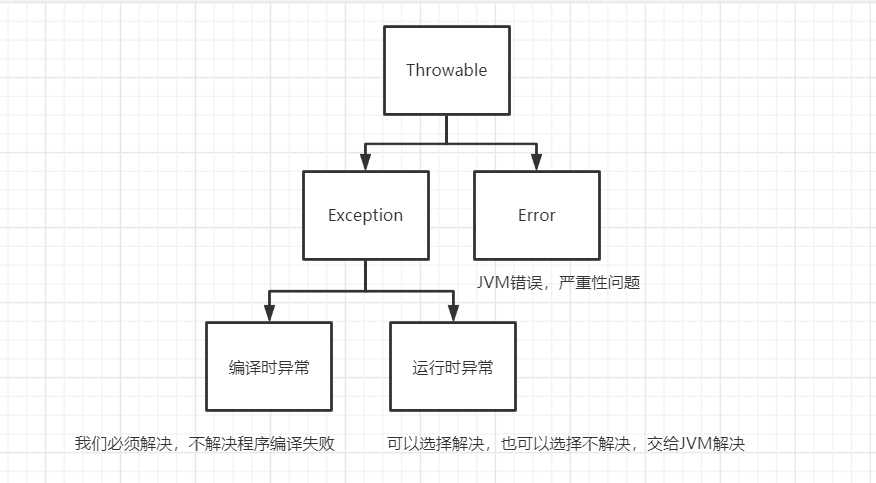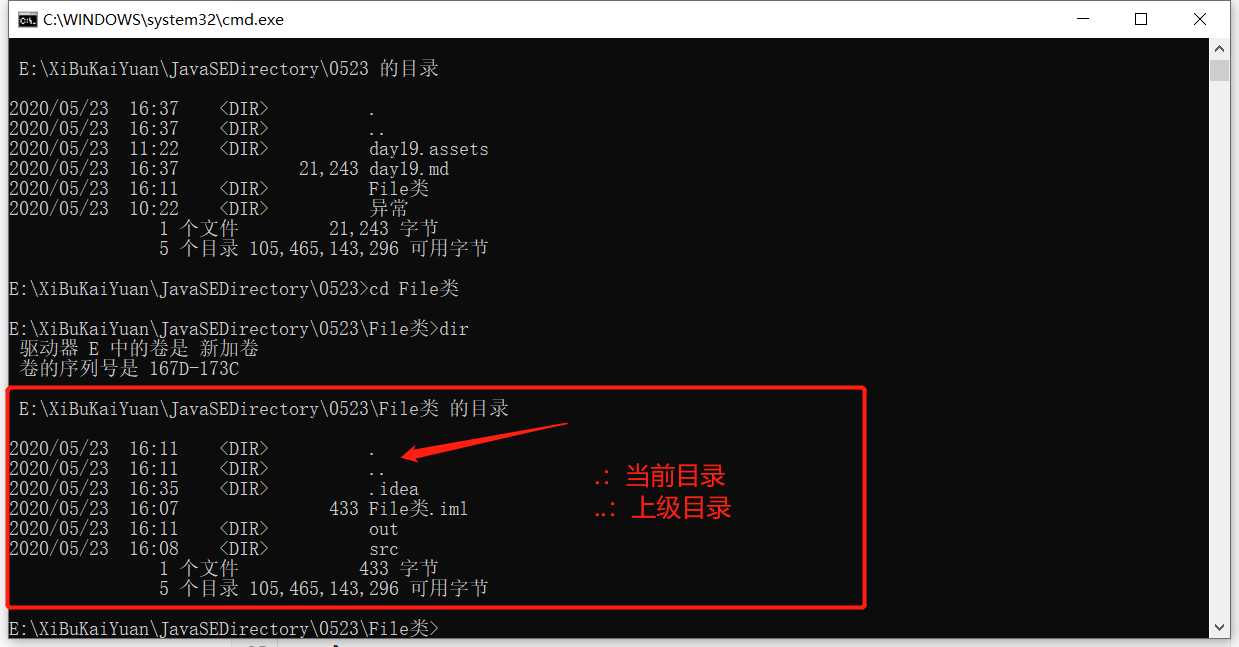标签:遇到 容量 inter return语句 ann jvm data mat 特殊

package org.westos.demo;
/**
* @author lwj
* @date 2020/5/23 10:12
*/
public class MyTest {
public static void main(String[] args) {
int[] arr = new int[]{1, 2, 3};
System.out.println(arr[3]);
System.out.println(arr[0]);
/*
Exception in thread "main" java.lang.ArrayIndexOutOfBoundsException: 3
at org.westos.demo.MyTest.main(MyTest.java:10)
Process finished with exit code 1
*/
/*
jvm默认处理运行期异常:打印异常的堆栈信息,并停止执行后续的代码。
*/
/*
public
class ArrayIndexOutOfBoundsException extends IndexOutOfBoundsException {}
public
class IndexOutOfBoundsException extends RuntimeException {}
*/
}
}
package org.westos.demo;
/**
* @author lwj
* @date 2020/5/23 10:36
*/
public class MyTest2 {
public static void main(String[] args) {
//System.out.println(10 / 0);
/*
Exception in thread "main" java.lang.ArithmeticException: / by zero
at org.westos.demo.MyTest2.main(MyTest2.java:9)
Process finished with exit code 1 进程异常终止
*/
try {
//try代码块存放有可能发生异常的代码
System.out.println(10 / 0);
} catch (RuntimeException e) {
//catch代码块存放异常的处理方式
e.printStackTrace();
}
System.out.println("try-catch成功,程序即使发生异常依然可以执行后续代码。");
/*
java.lang.ArithmeticException: / by zero
at org.westos.demo.MyTest2.main(MyTest2.java:20)
try-catch成功,程序即使发生异常依然可以执行后续代码。
Process finished with exit code 0 进程正常终止
*/
}
}
package org.westos.demo;
import java.util.Arrays;
/**
* @author lwj
* @date 2020/5/23 11:04
*/
public class MyTest3 {
public static void main(String[] args) {
int[] arr = new int[]{1, 2, 3};
arr = null;
try {
System.out.println(arr[0]);
System.out.println(10 / 0);
System.out.println(arr[3]);
} catch (NullPointerException e) {
System.out.println(e);
} catch (ArithmeticException e) {
e.printStackTrace();
} catch (ArrayIndexOutOfBoundsException e) {
System.out.println(Arrays.toString(e.getStackTrace()));
} catch (Exception e) {
//平级关系的异常前后无所谓,如果出现父子关系的异常,那么父类异常在后,子类异常在前
System.out.println("其他异常");
}
System.out.println("程序可以执行到这里。");
/*
java.lang.NullPointerException
程序可以执行到这里。
Process finished with exit code 0
*/
/*
程序执行到14行,出现空指针异常,第一个catch分支捕获到该异常,打印该异常对象e,然后不再执行try后面的代码
*/
}
}
JDK 1.7针对多个平级异常的处理
package org.westos.demo;
/**
* @author lwj
* @date 2020/5/23 11:15
*/
public class MyTest4 {
public static void main(String[] args) {
String str = "Hello";
String[] strs = new String[]{"Java", "JavaScript", "Python"};
try {
str = null;
System.out.println(str.length());
System.out.println(str.charAt(5));
System.out.println(strs[3]);
} catch (StringIndexOutOfBoundsException | ArrayIndexOutOfBoundsException | NullPointerException e) {
e.printStackTrace();
}
/*
java.lang.NullPointerException
at org.westos.demo.MyTest4.main(MyTest4.java:14)
Process finished with exit code 0
*/
}
}
好处:简化代码;
弊端:对多个异常的处理方式是一致的。
注意事项:
多个异常之间只能是平级的关系,不能出现子父类的继承关系。

Java中的异常分为两大类:编译时异常和运行时异常。
所有RuntimeException类及其子类的实例被称为运行时异常,其他的异常就是编译时异常。
编译时异常:Java程序必须显式处理,否则程序无法通过编译;
运行时异常:无需显式处理,也可以和编译期异常一样处理。
package org.westos.demo2;
import java.text.ParseException;
import java.text.SimpleDateFormat;
import java.util.Date;
/**
* @author lwj
* @date 2020/5/23 12:28
*/
public class MyTest {
public static void main(String[] args) {
//编译期异常
SimpleDateFormat sdf = new SimpleDateFormat("yyyy-MM-dd HH:mm:ss");
String s = "2020-05-23 12:30:17";
Date date = null;
try {
date = sdf.parse(s);
} catch (ParseException e) {
e.printStackTrace();
}
System.out.println(date);
//Sat May 23 12:30:17 CST 2020
/*
public Date parse(String source) throws ParseException
{
ParsePosition pos = new ParsePosition(0);
Date result = parse(source, pos);
if (pos.index == 0)
throw new ParseException("Unparseable date: \"" + source + "\"" ,
pos.errorIndex);
return result;
}
throw在方法内部主动抛出一个异常,throws在方法上,是处理异常除了try-catch的另一种方式
*/
}
}
编译期异常
解决:
package org.westos.demo3;
import java.text.ParseException;
/**
* @author lwj
* @date 2020/5/23 14:40
*/
public class MyTest {
public static void main(String[] args) {
try {
//try本来是存放可能会发生异常的代码
//现在却是肯定会发生异常的代码
throw new ParseException("aaa", 1);
} catch (ParseException e) {
//对于异常的处理,不要做空处理
e.printStackTrace();
//打印异常的详细堆栈信息(与jvm处理方式一致)
System.out.println(e.getMessage());
//获取异常信息,返回字符串
System.out.println(e.toString());
//获取异常类名和异常信息,返回字符串
}
System.out.println("Bye");
/*
java.text.ParseException: aaa
at org.westos.demo3.MyTest.main(MyTest.java:15)
aaa
java.text.ParseException: aaa
Bye
*/
}
}
利用异常机制录入一个整数
package org.westos.demo3;
import java.util.InputMismatchException;
import java.util.Scanner;
/**
* @author lwj
* @date 2020/5/23 14:50
*/
public class MyTest2 {
public static void main(String[] args) {
while (true) {
try {
Scanner sc = new Scanner(System.in);
System.out.println("请输入一个整数:");
int num = sc.nextInt();
System.out.println(num);
break;
} catch (InputMismatchException e) {
System.out.println("输入类型不正确,请重新输入");
}
}
/*
请输入一个整数:
12das
输入类型不正确,请重新输入
请输入一个整数:
12
12
Process finished with exit code 0
*/
}
}
package org.westos.demo3;
import java.text.ParseException;
import java.text.SimpleDateFormat;
import java.util.Date;
/**
* @author lwj
* @date 2020/5/23 14:53
*/
public class MyTest3 {
public static void main(String[] args) throws ParseException {
Date date = dateParseStr("2020-05-23 12:00");
//如果发生异常,交给jvm处理
System.out.println(date);
//Sat May 23 00:00:00 CST 2020
}
private static Date dateParseStr(String s) throws ParseException {
SimpleDateFormat sdf = new SimpleDateFormat("yyyy-MM-dd");
return sdf.parse(s);
}
}
异常
throws
throw
package org.westos.demo2;
import java.text.ParseException;
/**
* @author lwj
* @date 2020/5/23 13:51
*/
public class MyTest3 {
public static void main(String[] args) throws ParseException {
//throw new RuntimeException("");
/*
Exception in thread "main" java.lang.RuntimeException:
at org.westos.demo2.MyTest3.main(MyTest3.java:11)
Process finished with exit code 1
*/
/*
手动抛出异常
* 运行期异常:可以不处理,交给调用main的jvm处理
* 编译期异常:必须处理,throws向上抛出
*/
throw new ParseException("aaa", 1);
/*
Exception in thread "main" java.text.ParseException: aaa
at org.westos.demo2.MyTest3.main(MyTest3.java:26)
Process finished with exit code 1
*/
}
}
一般而言,工具类里的方法不要处理异常,最好抛出去让调用者处理异常逻辑。
throw抛出运行时异常
package org.westos.demo3;
/**
* @author lwj
* @date 2020/5/23 14:59
*/
public class MyTest4 {
public static void main(String[] args) {
System.out.println(10 / 0);
}
/*
Exception in thread "main" java.lang.ArithmeticException: / by zero
at org.westos.demo3.MyTest4.main(MyTest4.java:9)
Process finished with exit code 1
*/
public static int div(int a, int b) {
if (b == 0) {
throw new ArithmeticException("除数为0");
//抛出运行时异常
}
return a / b;
}
}
public ArrayList(int initialCapacity) {
if (initialCapacity > 0) {
this.elementData = new Object[initialCapacity];
} else if (initialCapacity == 0) {
this.elementData = EMPTY_ELEMENTDATA;
} else {
throw new IllegalArgumentException("Illegal Capacity: "+
initialCapacity);
}
}
public
class IllegalArgumentException extends RuntimeException {}
如果集合的初始化容量为负数,那么抛出非法参数异常(运行时异常),如果触发了该异常,那么交给jvm处理,停止程序。
被finally控制的语句体一定会执行(前提 jvm没有停止)
特殊情况:在执行到finally之前jvm退出了(比如System.exit(0))
用于释放资源,在IO流操作和数据库操作中会见到。
package org.westos.demo2;
import java.util.Scanner;
/**
* @author lwj
* @date 2020/5/23 13:37
*/
public class MyTest2 {
public static void main(String[] args) {
//shift + alt + 上/下键:上下移动光标所在行代码
Scanner sc = null;
try {
sc = new Scanner(System.in);
System.out.println("请输入第一个整数:");
int a = sc.nextInt();
System.out.println("请输入第二个整数:");
int b = sc.nextInt();
System.out.println(a / b);
} catch (ArithmeticException e) {
System.out.println(e.toString());
} finally {
//无论try代码块是否有异常,finally代码块中的代码都会执行
if (sc != null) {
sc.close();
}
}
System.out.println("Bye");
/*
请输入第一个整数:
12
请输入第二个整数:
0
java.lang.ArithmeticException: / by zero
Bye
*/
}
}
try-catch-finally与return的结合问题
结论:
1、不管try代码块是否有异常,finally代码块都会执行;
2、当try或者catch代码块中有return语句时,finally代码块也会执行;
3、finally是在return 后面的表达式运算后执行的,所以返回值是在finally执行前确定;
4、finally中最好不要包含return,否则程序会提前退出,返回值不是try/catch中保存的值。
举例:
1、try{} catch(){} finally{} return
程序按顺序执行
2、try{return} catch(){} finally{} return
程序执行try块中return之前的代码,包括return后面的表达式的运算,再执行finally块,最后执行try中的return。finally块之后的语句return,因为程序在try中已经return所以不再执行。
3、try{ } catch(){return;} finally{} return;
程序先执行try,如果遇到异常执行catch块,
有异常:则执行catch中return之前(包括return语句中的表达式运算)代码,再执行finally语句中全部代码,最后执行catch块中return. finally之后的代码不再执行。
无异常:执行完try再finally再return。
4、try{ return; }catch(){} finally{return;}
程序执行try块中return之前(包括return语句中的表达式运算)代码;再执行finally块,因为finally块中有return所以提前退出。
5、try{} catch(){return;}finally{return;}
程序执行catch块中return之前(包括return语句中的表达式运算)代码;再执行finally块,因为finally块中有return所以提前退出。
6、try{ return;}catch(){return;} finally{return;}
程序执行try块中return之前(包括return语句中的表达式运算)代码;
有异常:执行catch块中return之前(包括return语句中的表达式运算)代码;再执行finally块,因为finally块中有return所以提前退出。
无异常:则再执行finally块,因为finally块中有return所以提前退出。
Java提供的异常不能完成业务逻辑。
继承自Exception:编译时异常
继承自RuntimeException:运行时异常。
package org.westos.demo4;
/**
* @author lwj
* @date 2020/5/23 15:13
*/
public class MyException extends RuntimeException {
public MyException(String s) {
super(s);
}
}
package org.westos.demo4;
import java.util.Scanner;
/**
* @author lwj
* @date 2020/5/23 15:13
*/
public class MyTest {
public static void main(String[] args) {
Scanner sc = new Scanner(System.in);
System.out.println("请输入你的成绩:");
int score = sc.nextInt();
if (score > 100 || score < 0) {
throw new MyException("成绩无效");
}
System.out.println(score);
/*
请输入你的成绩:
101
Exception in thread "main" org.westos.demo4.MyException: 成绩无效
at org.westos.demo4.MyTest.main(MyTest.java:15)
Process finished with exit code 1
*/
}
}
(针对编译期异常)
在方法重写中,子类方法抛出的异常不能大于父类方法抛出的异常。
如果父类被重写的方法没有异常抛出,那么子类的方法绝对不能抛出异常,如果子类方法有异常发生,那么只可以try-catch,不可以throws。
子类方法的访问级别不能小于父类方法的访问级别
子类方法的返回值类型不能大于父类方法的返回值类型
子类方法抛出的异常不能大于父类方法抛出的异常
File(String pathname)
File(String parent, String child)
File(File parent, String child)
package org.westos.demo;
import java.io.File;
/**
* @author lwj
* @date 2020/5/23 16:08
*/
public class MyTest {
public static void main(String[] args) {
File file = new File("E:\\XiBuKaiYuan\\JavaSEDirectory\\0523\\day19.md");
System.out.println(file);
//E:\XiBuKaiYuan\JavaSEDirectory\0523\day19.md
File file1 = new File("E:\\XiBuKaiYuan\\JavaSEDirectory\\0523", "day19.md");
System.out.println(file1);
//E:\XiBuKaiYuan\JavaSEDirectory\0523\day19.md
File file2 = new File("E:\\XiBuKaiYuan\\JavaSEDirectory\\0523");
//目录对象
File file3 = new File(file2, "day19.md");
System.out.println(file3);
//E:\XiBuKaiYuan\JavaSEDirectory\0523\day19.md
System.out.println(File.separator);
// System.out.println(File.pathSeparator);
//; 与系统有关的路径分割符
}
}
相对路径与绝对路径
package org.westos.demo;
import java.io.File;
/**
* @author lwj
* @date 2020/5/23 16:27
*/
public class MyTest2 {
public static void main(String[] args) {
/*
绝对路径:带有盘符的详细路径
相对路径:不带盘符的路径,在Java程序中相对于当前项目下
*/
File file = new File("src\\org\\westos\\demo\\MyTest.java");
System.out.println(file);
//src\org\westos\demo\MyTest.java
System.out.println(file.getAbsolutePath());
//E:\XiBuKaiYuan\JavaSEDirectory\0523\File类\src\org\westos\demo\MyTest.java
System.out.println(new File(".").getAbsolutePath());
//E:\XiBuKaiYuan\JavaSEDirectory\0523\File类\.
//.代表当前目录
System.out.println(new File("..").getAbsolutePath());
//E:\XiBuKaiYuan\JavaSEDirectory\0523\File类\..
//点击上面的路径可以调到本地文件系统的0523目录下
}
}

| 方法名 | 描述 |
|---|---|
| public boolean createNewFile() | 当且仅当具有该名称的文件尚不存在时,创建一个路径名命名的新的空文件。 |
| public boolean mkdir() | 创建由此抽象路径名命名的目录 |
| public boolean mkdirs() | 创建由此抽象路径名命名的目录,包括任何必需但不存在的父目录。 |
package org.westos.demo;
import java.io.File;
import java.io.IOException;
/**
* @author lwj
* @date 2020/5/23 16:41
*/
public class MyTest3 {
public static void main(String[] args) {
File file = new File("src\\org\\westos\\demo\\a.txt");
try {
boolean newFile = file.createNewFile();
System.out.println(newFile);
//是否创建成功
//当第一次创建时返回true,如果已经存在,重复创建,返回false
} catch (IOException e) {
e.printStackTrace();
}
File file1 = new File("src\\org\\westos\\demo2");
boolean mkdir = file1.mkdir();
System.out.println(mkdir);
//是否创建成功
//当第一次创建时返回true,如果已经存在,重复创建,返回false
File file2 = new File(".\\src\\org\\test\\demo");
boolean mkdirs = file2.mkdirs();
System.out.println(mkdirs);
//是否创建成功
//当第一次创建时返回true,如果已经存在,重复创建,返回false
}
}
| 方法名 | 描述 |
|---|---|
| public boolean delete() | 删除由此抽象路径名表示的文件或目录 |
package org.westos.demo;
import java.io.File;
/**
* @author lwj
* @date 2020/5/23 16:54
*/
public class MyTest4 {
public static void main(String[] args) {
//删除文件
File file = new File("src\\org\\westos\\demo\\a.txt");
boolean delete = file.delete();
System.out.println(delete);
//true
//注意事项:Java中的删除不走回收站。要删除一个文件夹,请注意该文件夹内不能包含文件或者文件夹
File file1 = new File("src\\org\\test");
boolean delete1 = file1.delete();
System.out.println(delete1);
//false
//test文件夹下含有demo文件夹
File file2 = new File("src\\org\\test\\demo");
boolean delete2 = file2.delete();
System.out.println(delete2);
//true
//demo文件夹已被删除,test文件夹没有子文件夹
boolean delete3 = file1.delete();
System.out.println(delete3);
//true
}
}
标签:遇到 容量 inter return语句 ann jvm data mat 特殊
原文地址:https://www.cnblogs.com/shawnyue-08/p/12943566.html